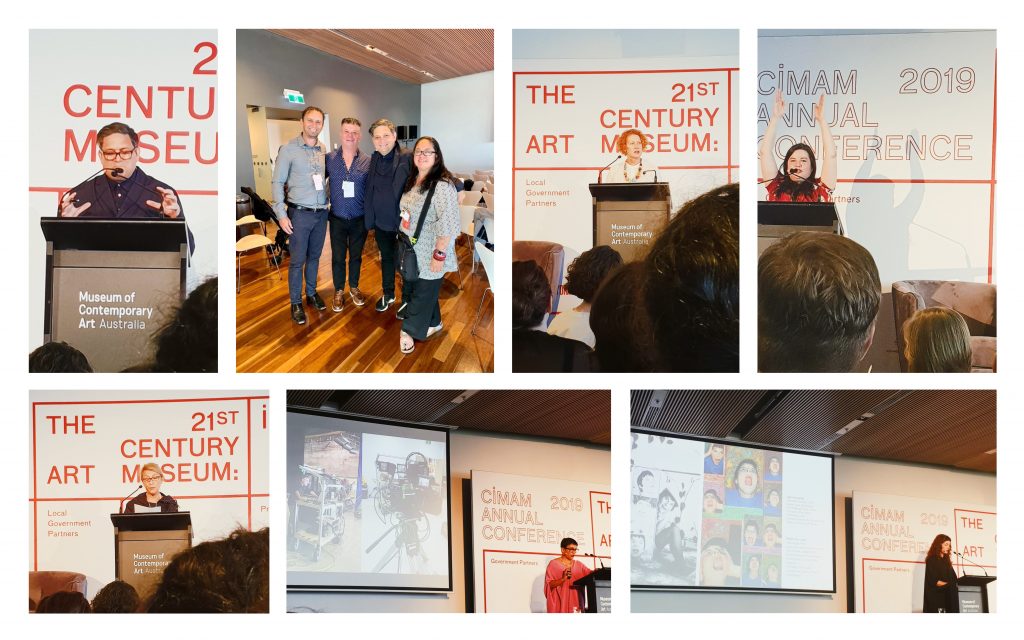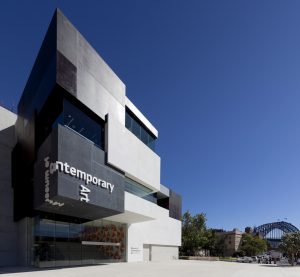
First Nations cultures, their representations and participation in art museums around the world, were front and centre at an international art conference held at the Museum of Contemporary Art Australia (MCA) this past weekend. The International Committee for Museums and Collections of Modern Art conference (CIMAM) brought together representatives from many of the world’s best art institutions.
The conference’s theme – The 21st Century Art Museum: Is Context Everything? had a referential awareness of its host city from the packed venue of the MCA Harbourside Terrace overlooking the Sydney Harbour, to tours for participants of the streets and galleries of the inner city encompassing Woolloomooloo (Artspace and Firstdraft), Chinatown (4A Centre for Contemporary Asian Art), and the multilayered street art of a gentrifying Redfern.
In her initial address, CIMAM Chair, Elizabeth Ann Macgregor, Director, Museum of Contemporary Art Australia, told the gathering that with Context is Everything as the theme, the conference had to begin with a focus on First Nations people and cultures. After a Welcome to Country by Metro Land Council Chair Yvonne Weldon, the Friday theme of Challenging the narrative: Indigenous Perspectives could not have had a better start than from Sydney Festival Director, Wesley Enoch. In his presentation, entitled Why So Many Walls? Enoch startled some of the gathering with the suggestion that the valuable collections of institutions were in fact detritus and not the embodiment of culture. “The things left behind are a cultural memory of an action, a practice, a ceremony that has been designed to be discarded and disposed of, having fulfilled its purpose, rather than collected to adorn the walls,” Wesley said. “This is Indigenous Perspective.”
By the time Stephen Gilchrist, University of NSW Associate Lecturer of Indigenous Art, had conducted the morning panel session with Wesley, Wanda Nanibush, Curator of Indigenous Art from the Art Gallery of Toronto and Ngahiraka Mason, Hawaiian Indigenous Curator and Visual Historian, delegates had been immersed in Indigenous perspectives and a feast of ideas, all in the space of a morning. As the panel had pre-arranged to not receive questions from the audience, delegates were hungry for more.
As a guest at the conference, thanks to Create NSW, I was impressed by all the other delegates who were so generous and intelligent in their curiosity about First Nations culture and people. At times it was a dizzying line up of conversations with directors and curators from Finland, Russia, England, Switzerland, Poland, Nepal, New Zealand, Brazil, China, Japan, the US and so many more. It was also not all about us, although First Nations continued as a thread throughout the conference and site visits, which included Carriageworks and the Art Gallery of NSW.
In the middle of the program, delegates broke into pre-selected discussion workshops on climate change, activism, populism and censorship, digital disruption and the idea of the museum as a refuge. Discussions were lively and well facilitated, demonstrating the currency of art and the centrality of art museums in the public discourse, often in surprising ways.
By the final day, there was still a buzz and a desire to see, hear and learn more. With so many attendees travelling internationally, those who opted for the extension were looking forward to leaving early the next day for the Brisbane tour and to meet with the Aboriginal people of Minjerribah (Stradbroke Island).
The conference was an absolute triumph for Macgregor as outgoing CIMAM Chair and her team. This was reflected in the high praise from all, with a high bar set for next year’s hosts, Łódź and Gdańsk, Poland.
Steve Miller
Aboriginal Programs Manager




